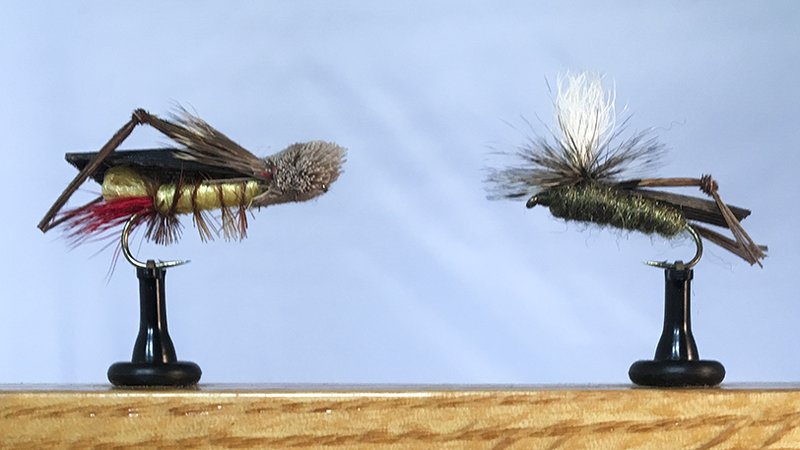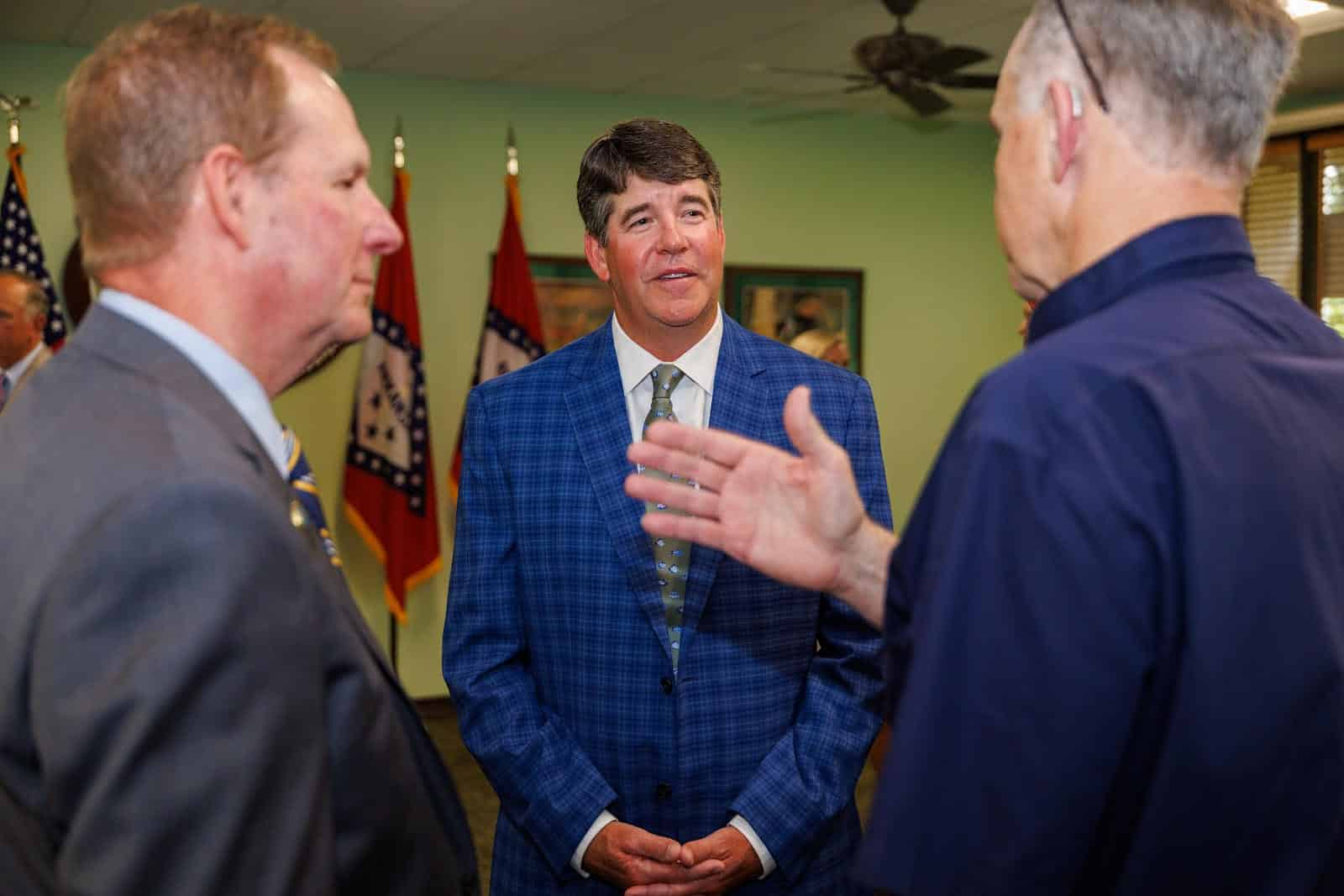Dastardly hot hoppers
ON 07-03-2019

July 3, 2019
Denis Dunderdale
North Central Regional Educator
MOUNTAIN HOME — The dog days of summer in Arkansas can be downright, dastardly hot. Fly fishing in the Ozarks during this time, however, can have its benefits. The tailwaters of Bull Shoals, Norfork, and Greer’s Ferry Lakes, as well as the Spring River, are cold – usually 50 to 60 degrees. That’s bonus wading when the air temperature hits the high 90s or triple digits. As summer progresses, grasshoppers get bigger, fatter, and juicer. Many that live in the riparian edges of the river find they have jumped, fallen or landed in that cold water – where the trout lie and wait. That’s where more astute fly fishers will be, as well.
Hopper fishing is a time-tested, tradition of angling that goes back into the ages. The historical legends of British fly fishing, Charles Cotton and Sir Isaac Walton both mentioned the use of hoppers in the 1600s. For various reasons, hoppers didn’t really gain popularity until the Twentieth Century, when, in the 1930s, the “Golden Age of American Fly Fishing”, unveiled the still-used “Joe’s Hopper’ and the “Letort’s Hopper.” A bit later, in the 1970s, Dave Whitlock came up with “Dave’s Hopper” as a further development of Art Winnie’s Joe’s Hopper. Hundreds of successful grasshopper, cricket, ant and other terrestrial patterns have been gracing fly boxes around the world ever since. Although the term “terrestrials” is technically correct, if you just mention “hoppers” to practically any fly angler, they will know what you mean.
Hopper-patterned flies are most effective where the river bank is edged by tall grass, bushes and overhanging trees, where the crickets miss their mark and inadvertently land in the water. The trout await and take full advantage of the terrestrial’s mishap.
Even novice anglers can quickly master hopper fishing. They can throw away some of what was taught during those casting lessons. The presentation technique should replicate the “splat” with which a katydid might hit the water. Even the crudest of presentations will be effective. The “splattier,” the better. Forget that well-groomed drag-free-drift too. That may be essential for an earlier season mayfly presentation, but in this situation, it will get you nowhere. Think inch-and-a-quarter-long, panic stricken, grasshopper with the gracefulness of a wet squirrel. Keep in mind, these critters are not likely to land 50 feet from the water’s edge. Keep it close to the bank, but be positioned so as not to cast a shadow over the target, which will spook the fish. Once the bug crash lands on the water, the angler should twitch it along the surface, creating a miniature wake. Twitch, pause, twitch, twitch, pause. Keeping the twitches rather short, but pronounced – about an inch. A hopper isn’t able to move four inches with one leg kick. Fish usually assault these bugs with an explosion. Newer fly fishers have the tendency to set the hook as soon as the fish strikes, this can pull the fly away from the fish, resulting in a language one should not use in front of one’s mother. With just a bit of experience, the angler will pause for a second, allowing the fish to turn downward, setting the hook themselves.
There is a common variation on this theme, affectionately known as the “Hopper and Dropper.” Tie a midge, nymph or other smaller, sub-surface fly of your choice, 12 to 18 inches below the bend of the hopper’s hook, using fairly fine tippet. Casting a fly with a dropper, and keeping it tangle free, takes a bit of practice, but it will unveil yet another dimension of fly fishing. Sometimes, the fish go for the hopper, and sometimes for the dropper. The hopper can be used as a strike indicator, in which case, watching for a subtle twitch, pause or sinking of the surface fly indicates a take on the sub-surface fly. Otherwise, the rest of the technique is pretty much the same as stated above.
For the fly tier, there are two approaches – simple and complex. The simple approach involves the use of sheet foam. With this material, there are no limits to the colors, sizes and shapes tiers can create. A quick internet search for “Foam Hopper Fly Patterns” will uncover an abundance of choices that are fairly easy to tie and float like corks. For the more ambitious, there are several options. Keep in mind that buoyancy is the name of the game. Dave’s Hopper is one of the most popular in today’s world. This is a relatively complex pattern with quite a few steps, some of which involve spinning deer hair. Dave developed the Dave’s Hopper as an advancement of the famed Joe’s Hopper. Mr. Whitlock has a video series called “Tying and Fishing the Dave Whitlock Originals.” Volume One features the “Dave’s Hopper” and the “Whit Hopper.” The Whit Hopper is also made with deer hair but doesn’t call for spinning the hair. And according to Dave, is a more realistic fly that more closely represents the natural.
Hopper fishing is not only effective for trout. Smallmouth bass will eat these bugs too. When the waters of Ozark streams warm and get lower, the fish tend to hold in the deeper holes. Here, the best chances involve fishing the surface of the deeper holes, where the bass tend to be. For that matter, any fish that would eat a grasshopper, cricket, katydid or other terrestrial insect will fall for this tactic. That means anyone with access to a farm pond with bass, bluegill or other bream can enjoy an action-packed day of fly fishing, even when it’s dastardly hot.
Recent News

Arkansas Wildlife Weekly Fishing Report
Jul. 10, 2025

Lonoke aquaculturist named to AGFC
Jul. 10, 2025
Subscribe to Our Weekly Newsletter E-mails
Don’t miss another issue. Sign up now to receive the AGFC Wildlife Weekly Newsletter in your mailbox every Wednesday afternoon (Waterfowl Reports are published weekly during waterfowl season and periodically outside the season). Fishing Reports arrive on Thursdays. Fill in the following fields and hit submit. Thanks, and welcome!
